Generalized Body Rashes
Rashes are common in childhood and the causes are numerous. Below are some common rashes that we see in the office. More detailed information may be found by clicking on rash titles or by visiting this website from the American Academy of Pediatrics: https://www.healthychildren.org/English/health-issues/conditions/skin/Pages/default.aspx
The majority of rashes that your child will have will not be harmful and resolve without intervention; however, you should call the office if:
-
- Your child has a purple colored rash that may resemble bruising. We should see this immediately as it may indicated bleeding under the skin.
- Your child has a rash and fever.
- Your child is or has recently been on medication and now has a rash.
- The rash is open or has discharge/oozing.
- The rash is very bothersome.
Hives
Rash appears as raised, red welts and is typically very itchy.
-
- May be a reaction to food, something that has touched the skin, medication or a virus.
- Home management may include oral antihistamines (Benadryl or Zyrtec).
- Call the office if:
- Hives appear shortly after eating a new food.
- You child has abrupt onset of hives with any of the following: vomiting, facial swelling, trouble breathing, lip swelling. This may be a serious allergic reaction and your child needs to be seen IMMEDIATELY!
- Hives are seen while your child is taking a prescription medication.
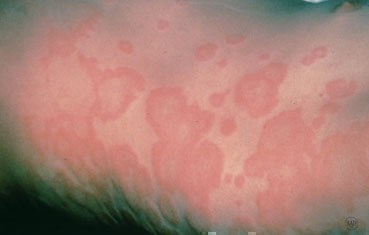
Viral Exanthem
Has your child had a recent viral illness and at the end of illness or after the fever subsides you now see a rash? This is likely a common viral exanthem. It is not harmful, bothersome, nor contagious (if no fever and no open lesions) and will resolve on it’s own without intervention.

Hand, Foot and Mouth (Coxsackie virus)
Blisters on the palms of the hand, soles of the feet and in the mouth.
-
- Treatment is focused on comfort (tylenol or motrin for pain) and hydration (ensure your child is drinking).
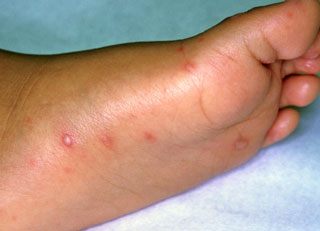
Noticed most on hot days, tiny red bumps may form in sweat-prone areas like the neck folds, diaper area, arm and leg folds.
-
- Treatment includes cooling the child down and keeping skin dry.
Appears first as bright red rash on both cheeks that may look like a “slapped- cheek” then you may notice a lace-like rash on the arms.
-
- Most common late winter & early spring.
- Typically treated with supportive/comfort care.
- May be harmful to developing fetus. Pregnant women should call their doctor immediately.
Open sores typically seen under nose and on the chin. Covered with honey-color scabs. Can spread to other areas nearby.
-
- Typically treated with prescription antibiotic ointment.
- Contagious – may return to school 24 hours after starting treatment.
- Please schedule a visit or come to walk in hour for assessment.
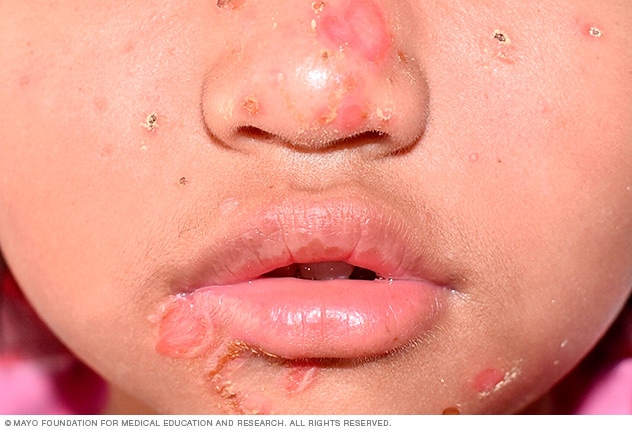
Red, round or oval patches with raised, scaly boarder. Center is usually clear. May be itchy. May spread to other body areas.
-
- May be treated with over-the-counter antifungal cream like clotrimazole. Some cases may require prescription treatment. Should be seen in office if worsening or if on the scalp.
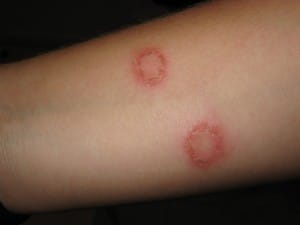
Small, raised, white/pink/or flesh-colored bumps with a dimple or pit in the center. Can be found anywhere on the body.
-
- May spread to other areas of the body or to other people. To limit this, avoid scratching and avoid sharing towels, clothing or bedding.
- Will resolve on it’s own without intervention but it is very slow to resolve and may take years in some cases. Average time to resolve is 6-12 months.
- Severe cases (many lesions, bothersome or on genital areas) may require treatment.
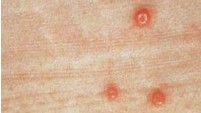
Image Sources:
-
- Hives: American Academy of Dermatology https://www.aad.org/public/diseases/itchy-skin/hives
- Viral exanthem: Image Copyright:DR P. MARAZZI/SCIENCE PHOTO LIBRARY(https://www.sciencedirect.com/science/article/pii/S1357303917302517)
- Coxsackie: Self Care Decisions, LLC. From the Dr. William Weston Collection of Pediatric Dermtology. (www.healthychildren.org)
- Impetigo: Mayo Clinic https://www.mayoclinic.org/diseases-conditions/impetigo/symptoms-causes/syc-20352352
- Ringworm: Children’s Hospital Los Angeles https://www.chla.org/blog/rn-remedies/getting-the-root-ringworm-causes-and-prevention
- Molluscum: https://www.cdc.gov/molluscum-contagiosum/about/index.html
